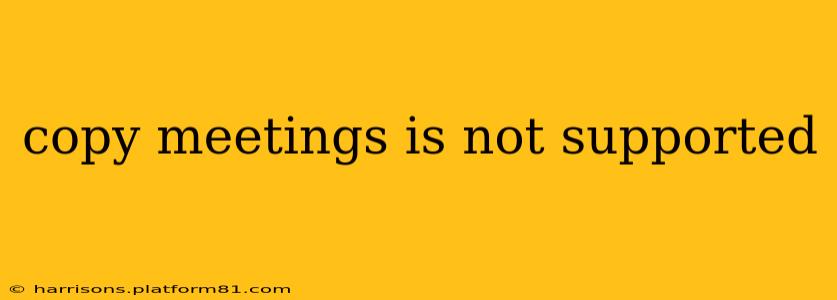Copy Meetings: Why They're Often Unsuccessful and How to Improve Them
The phrase "copy meetings are not supported" often reflects a frustration with the inefficiency of meetings focused solely on reviewing and approving marketing copy. These meetings can quickly devolve into tedious line-by-line edits, stalled progress, and ultimately, wasted time. But why is this the case, and what can be done to make copy review a more productive and valuable process? This article delves into the common pitfalls of copy meetings and offers actionable strategies for improvement.
Why are copy meetings often ineffective?
Ineffective copy meetings often stem from a lack of preparation, unclear objectives, and a failure to leverage the strengths of collaborative tools. Here's a breakdown of common issues:
-
Lack of clear objectives: Without a defined agenda and clear goals, copy meetings become rambling sessions with no decisive outcomes. Participants might wander off-topic, leading to frustration and unproductive time spent.
-
Poor preparation: Attendees arriving unprepared, without having reviewed the copy beforehand, severely limits the meeting's effectiveness. This leads to wasted time on initial readings and prevents focused discussion on critical areas.
-
Too many cooks in the kitchen: Inviting too many stakeholders without clearly defined roles and responsibilities can lead to conflicting opinions and slow down the decision-making process. Too many voices can also stifle creativity and lead to groupthink.
-
Focus on minor edits instead of strategy: Copy meetings should focus on the bigger picture – the message, the target audience, and the overall marketing strategy. Getting bogged down in minor grammatical tweaks is a surefire way to waste time and stifle creativity.
-
Lack of collaborative tools: Relying solely on in-person meetings or email chains for feedback can be incredibly inefficient. Using collaborative document editing tools allows for simultaneous feedback and avoids the "he said, she said" confusion.
How to run more productive copy review sessions
Transforming copy review from a dreaded meeting into a valuable process requires a strategic shift in approach. Here are some key strategies:
-
Define clear objectives and circulate the copy beforehand: Before the meeting, share the copy with all attendees and clearly state the goals of the review (e.g., feedback on messaging, identification of potential legal issues, approval for launch).
-
Establish clear roles and responsibilities: Assign specific roles to participants (e.g., lead reviewer, copy editor, legal review). This ensures everyone understands their contribution and prevents overlap.
-
Focus on high-level feedback first: Start by discussing the overall message, target audience, and strategic alignment before delving into specific word choices.
-
Leverage collaborative tools: Utilize tools like Google Docs or Microsoft Word's track changes feature for real-time collaboration and feedback. This minimizes email chains and makes the process more efficient.
-
Timeboxing and sticking to the agenda: Set a time limit for the meeting and adhere to the agenda. If the discussion veers off-topic, gently steer it back.
-
Document decisions and action items: Summarize key decisions and assign action items with clear deadlines to ensure accountability.
What are the best practices for efficient copy review?
Efficient copy review hinges on proactive planning and the strategic utilization of resources. Key practices include:
-
Pre-read and provide written feedback before the meeting: This allows for a more focused discussion during the meeting itself.
-
Use a standardized feedback form: Creating a template for providing feedback ensures consistency and helps to focus the discussion.
-
Prioritize feedback: Not all comments are created equal. Focus on feedback that addresses the core message, clarity, and overall effectiveness.
-
Iterate and refine: Copywriting is an iterative process. Don't expect perfection on the first pass.
By implementing these strategies, you can transform your copy review process from a source of frustration into a collaborative and productive session, maximizing the effectiveness of your marketing efforts. Remember, the goal isn't just to approve copy; it's to create compelling, effective content that achieves your marketing objectives.
